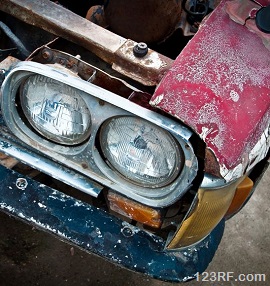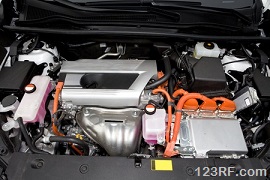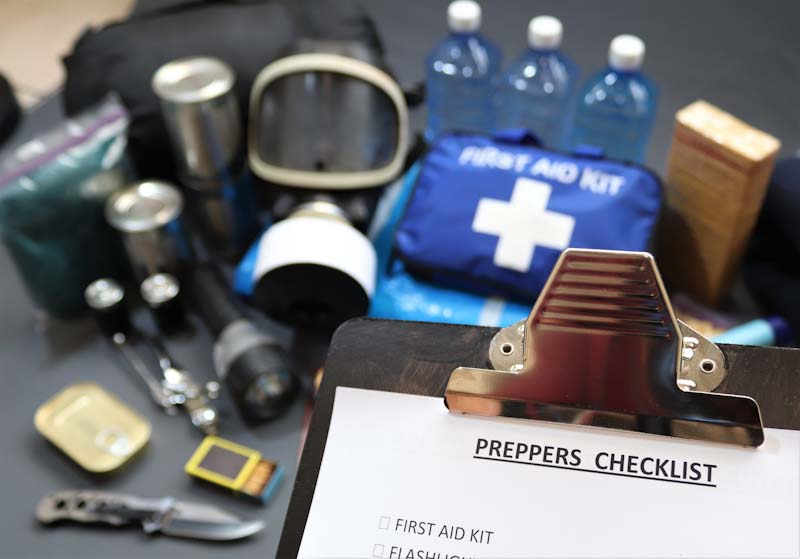Today, many people believe they can go back to earlier system designs and retrofit modern vehicles to these specifications, as this would be one of the best ways to protect their vehicles in case of an EMP.
While this can work in some systems, it is not likely to work in others. Some older system methods were simply too dangerous or broke down too often, hence the need for motorized or even computer controlled assemblies. But it’s common science that more computers mean more vulnerability during any EMP scenario.
What would be the best choice then?
Read this article, then learn how to replace the parts for the most affected five systems of your car as opposed to changing the systems altogether.
What Is the Most EMP Resistant Car?
Aside from the oldest vehicles that used a crank instead of an electronic ignition system, your best options will include older vehicles with as few computerized, motorized, or electronic parts as possible. Sadly, even these vehicles can be destroyed even after being retrofitted.
So, if you are interested in having a functional car outside of ground zero created by an EMP event, there are many cars sitting in junk yards that can be suitably retrofitted. Sadly, there are many vehicles that were turned over during the “Cash for Clunkers” program that could have been retrofitted.
If any of these vehicles haven’t been crushed or completely destroyed, you will have to do an enormous amount of work just too legally put them back on the road.
On the other hand, if your goal is to create a viable EMP proof car and you have the time, money, and patience to make the car roadworthy, then you can truly start your search for pre-’80’s cars in the local scrap and junk yards. If you look at modern cars, it can be very easy to forget just how close they are to the roadway.
While this may not be of much consequence now, low suspension systems can cause all kinds of problems in off road situations. This is just one of many reasons why you may not necessarily want to spend a fortune in time, effort, and money on EMP proofing a conventional vehicle. Instead, you may want to look at ATVs and other off-road vehicles that can be used for bugging out.
But can you make the car system work after an EMP or you just have to stash them for a further replacement? Let’s see how to EMP proof some of the most important systems of your car and what parts to stash for future times.
5 Crucial Systems and What You Need to Keep Them Work
The Computers
It is more than obvious that the computers will be the most affected part by an EMP. The best way to prevent it to disable it, dismantle it, and get rid of it any way you can.
Store any module that you cannot do without in a Faraday cage. Be prepared to spend several hundred to several thousand dollars on the parts plus tools required to calibrate the computers and sensors after they are installed.
The Electrical System

You are best served by learning how to replace each part if needed, and then retrofit anything that is currently integrated into a computerized system. Your best options include studying cars from the 70’s since these vehicles had a number of electric devices, but not computer systems that are the most vulnerable to EMP blasts.
If you want to add some parts to your car survival stockpile, store extra wire for the harness, an alternator, remote starter, wire continuity tester, extra batteries, independent battery charger, extra belts for the alternator, extra fuses.
The Ignition System
Even though older vehicles were started up by using a crank system, it is not necessarily a good idea to follow this path for EMP proofing your own vehicle. Among other things, crank systems often led to all kinds of injuries that will hamper your ability to survive in a post crisis world. You will be best served by leaving the ignition system as intact as possible.
If you can find a way to eliminate computer sensors and systems instead, go ahead and do so. This includes keyless starting systems as well as ones that utilize microchip embedded keys. There are many other ways to protect your vehicle from theft or unauthorized use without resorting to computer based systems that will completely disable an otherwise functional car after an EMP.
Store away at least one spare starter and extra battery wires and terminals.
The Emission System
At the current time, it is not legal to remove devices such as the catalytic converter, EVAP system, EGR valve and other emission systems parts. But you can, and should know how to remove them if they are damaged during an EMP blast.
It is up to you to decide if you want to sacrifice some of the fuel efficiency created by the emissions system or if you just want to get rid of it for the sake of avoiding additional complexities.
It is also important to study computer and fuse integration schematics so that you know which parts to cut out or disable once the emission devices are removed from the system.
Since manufacturers do not want these devices removed, rest assured there are likely to be redundancies in the fuse and computer systems that will prevent the vehicle from running if appropriate signals are not received from the emission control devices. Even if you did everything else right, this one tiny thing can prevent an otherwise functional vehicle from starting up and running.
You should store any parts that you intend to replace if they happen to be damaged by an EMP. You should also store away extra exhaust pipe in case you decide to get rid of the catalytic converter.
The Cooling System
Every part of the cooling system is absolutely necessary for proper vehicle function. For example, without oil and an oil pump, the engine will overheat and seize. By the same token, radiator fans and the rest of the cooling system are all vital no matter whether the vehicle is operating in cold temperatures or warmer ones.
You need to store thermostats, oil pumps, radiator fans. Consult the shop manual for your vehicle to find out what parts are computer controlled. Look for older designs that do not rely on computers and see if you can retrofit these elements.
You may need to work with a professional machinist to make new parts that can be exchanged for those now being controlled via a computer system. When it doubt or searching for ideas, look at the cooling systems for very early internal combustion vehicles. Follow their path of evolution until you arrive at a balance that safeguards the cooling system and still delivers sufficient cooling for your vehicle.
Never forget that modern vehicle engines also tend to run hotter than engines in older vehicles. Make sure that you know the temperature ranges you are dealing with so that you can design suitable and durable alterations.
If you are planning to EMP proof a hybrid or electric vehicle, you will be faced with a challenging if not impossible task for every system in the vehicle. For cooling systems, you will need to find some way to keep the battery packs cool without relying on computer systems. You can try using basic electronic components and conventional switches that you control manually from inside the vehicle.

Unfortunately, simply reading the shop manual for these vehicles and trying to transfer skills learned with conventional vehicles may not always be successful, let alone safe.
As for doors and windows, if your vehicle has power windows, doors, and seat belts, get rid of them immediately. Do everything you can to retrofit to crank handles for the windows, keyed (not microchip keys) locks, and manual seat belts.
This may well save your life if you are ever trapped in a vehicle during a crash as well as during an EMP. Without a question, if there is a place in a motor vehicle where computers pose a serious and constant hazard to occupants, this is it!
As long as you retrofit your vehicle to manual systems, you will not need to store away special parts. In fact, even if an inner door handle breaks off, a bit of duct tape and a nail will work just as well the way electronic safety systems, doors, and windows are set up.
While it may be a tiny bit inconvenient to use manual systems, they will always work perfectly even if there is no power to run a motor.
As you see, most EMP proofing for vehicles involves finding workarounds for motors and computer systems. In these days, you will find that conventional cars can still be converted, however it is much harder than it would be with an older vehicle.
Overall, you will also find that it is essentially pointless to try and EMP proof a hybrid or electric vehicle. The best thing you can do with these vehicles is try to at least return to manual doors, seat belts, and windows.
At the very least, you won’t be trapped inside the vehicle with no way to get out. Failing that, never drive off in a hybrid vehicle unless you have something to break the windows within easy reach.
Interested in the full list of car parts to store for EMP survival? CLICK HERE to find out more!









Pingback:How To EMP Proof 5 Crucial Systems Of Your Car - Survivalot | October 22, 2015
|
Pingback:How To EMP Proof 5 Crucial Systems Of Your Car - Survival By Preparedness | October 22, 2015
|
Teddy | October 22, 2015
|
Ridiclous article with superfluous information not related to the subject.
I rebuild, re-engineer ansd upgrade classic sports car Corvettes completely myself – everything from interior, engine, transmission, body, paint and everything else not mentioned!
carmela tyrrell | October 22, 2015
|
Teddy,
Thankyou for your feedback.
I am sure, if you have done any amount of work on cars, then you also know that even a generic “how to” text books runs 500 – 1000 pages; not to mention more specific ones for rebuilding brake systems and such. Beyond that – even the Chilton’s guides for specific cars only go so far, and then you have to go to the manufacturer’s shop manuals. I don’t know about you, but I’d hate to have something attached to my name that implied a person could pick up a “How to” book dedicated to Ford vehicles and then have people think they could get under the hood of a Honda, GM, etc etc etc. Even though vehicles all have the same basic parts, they are organized in different ways, may have different bolt torques… etc.
From that perspective – it i s not possible to do a “how to” – in fact I have in the past asked if readers would prefer a series of DIYs so that I could show them on a real car and in real time. It did not seem many were interested, so it seemed best to hold off on getting a vehicle I could use for exploratory purposes plus allocate the time and budget to completing the task (even though I would dearly love to do an EMP proofed car). Thus, it seemed best to give people some ideas about what systems need to be modified so that they can use that as a basis to go out and get more information about their vehicle, and if needed, find a reasonable mechanic to do the job.
Bill Keen | October 26, 2015
|
Carmella I find that your article has the typical ignorance factor regarding EMP.
You say that ALL systems that have ANY wiring/electrical components will be destroyed by ANY EMP! This is patently FALSE.
The main factors with any EMP are the amplitude and duration.
The systems currently buried in most cities at the Stop Line of major streets will destroy the computer in anything but a “Police Vehicle”. This is so that they can control the traffic movement and the collection of idiots who will remain in their cars WAITING. You can identify this be the narrow rectangle that is running down the Lane Dividing Stripe which is between the lanes.
This system has a relatively short duration and limited amplitude. It will not affect anything more than a couple of feet away from the center stripes. By eliminating the front row at each/every traffic signal, the LEO and Fire vehicles can use the opposite lanes to travel freely.
The amplitude of a High altitude EMP will be much greater of course but it STILL will NOT affect anything that works on AC power as the duration will be fairly short. The EMP destroys by exceeding the current limits of the device.
Since micro-circuits are exactly that, microscopic in size, they utilize extremely small currents to operate. These integrated circuits can be damaged/destroyed by simply handling them without the proper precautions. The static electricity you create by moving your arms while wearing stay-pressed clothing will do the trick.
The previous NATURAL EMP damage was caused by the Aurora Borealis which was continuous for a LONG time. With the input wires stretching for many miles, this caused fires in power lines and any equipment attached to them.
The duration of an explosion creating an EMP will only be the length of time that you can HEAR it! An explosion, by definition, is instantaneous and so short-lived.
The damage to power-grid components will be restricted to the control circuits and the possible tripping of the circuit-breakers at each transformer.
As for ‘retro-fitting’ a car for manual windows, you obviously have no idea of what is involved. The real reason that today’s cars use electronic motors to do things is the weight and SPACE required for mechanical operation. The doors are not configured to allow for mechanical regulators.
To remove the computer and ALL sensors from any post-1985 car/truck would probably be not just cost-prohibitive but also NEARLY IMPOSSIBLE!
These engines do NOT have distributors! Without a distributor, it takes a computer to properly time each cylinder’s firing. Now, I am sure that someone COULD create a Damper Pulley driven timing mechanism but it would NOT be reliable even with a notched serpentine belt.
This is why diesels are so popular with the Prepper Crowd. Diesels do not require a firing signal, only a Starting Motor which as I stated earlier should not be affected by EMP. However, nearly everything else DOES require integrated circuits in the cabin to operate; the radio, instruments, and sometimes lighting.
Bill Keen | October 26, 2015
|
FYI, the thing that MAKES a ‘Police Car’ different from any other vehicle is the “Wiring Grounding Package” that is an option that is not available to the average purchaser/donor.
With the proper shielding/grounding, the electronics in these will not be affected by most (City Installed) EMP sources. This does not mean that the HEMP explosion would NOT affect them as well as the amplitude will be much greater.
Andi | October 22, 2015
|
Teddy, it sounds like you are well qualified to comment on this subject. I find this article extremely un-usable, unrealistic. Like an armchair mechanic telling you how to reengineer your car.
There is not much need to EMP proof a car since that situation means it is the end of the world as we know it. So what if yours is the only car still running? That may sound like a real advantage but it also makes you a target (you have something others want desperately). So how long will you be able to drive this car before you run out of gas. Even if you stockpile fuel, it wont keep very long, even with stabilizers. Seems like time, money, and effort would be spent in other preps.
The one advantage I do see in a working car after EMP would be to get you to a safe location to hunker down and start your life over again. It would likely be the last time you would drive it anyway.
gino schafer | October 23, 2015
|
If you have the time, money and know how, of how to EMP proof your car, then it is a good thing to do so. You can just wave at those guys as they drive by you, hopefully leaving you in their dust, Andi.
Georg An Hudak | October 22, 2015
|
I’m a 65 yr. old grandma who doesn’t know how to do any of this stuff. What vehicle currently available would you recommend? ATV’s, motorcycle? What would be easiest & most secure? Is there anything not vulnerable to EMPs besides a bicycle?
Survivopedia | October 22, 2015
|
Thank you for asking, Georg An. There are other options than a car. Here is our selection: http://www.survivopedia.com/best-emp-bug-out-vehicles/
davida | January 29, 2016
|
fariday cage a v w bug in a shipping container if serious …. but whats wrong with a horse and saddle?
may as well get used to the idea your gonna live in the 1880’s in the middle of no where from then on out. my advise is find out how they did things then.
Jim Dahl | October 22, 2015
|
Hi,
I have been a full time mechanic for 40 years now. The old Ford 300 six cylinder found in pickups and cars can be retrofitted with point and condenser
ignition systems. Also good candidates are older Chevy six cylinders and Chrysler products in the “slant six” design. V8s of the same years are of course OK
but a bit more complicated. Keep extra points and condensers and coils. Add gas and go!
Thanks for the good info,
Jim
Desert Fox | October 22, 2015
|
I started reading this article with high hope that I would learn something…however, all it gave you are lists of parts that only mechanics are familiar with and have a load of money to buy! Your title is definitely misleading…a “How To” should read: “A list of Parts to”
Mike Maness | October 22, 2015
|
My solution to EMP was to have my car modified to run on both unleaded or propane. On my dash is a toggle switch. It electrically turns off the fuel injection system and unleaded fuel pump and turns on the propane valve. The propane has a mechanical carburetor that is ducted into the engine’s air intake.
Conversely, if I want to run on unleaded, I flip the switch the other way and my propane valve shuts off, and my fuel pump pressurizes. The inlet air for my engine goes through the propane carburetor which is now just an air passage. The air filter is located on the inlet of the propane carburetor. I can be driving down the road and run out of propane and just flip the switch and keep going. I have two, 5 gallon propane tanks mounted in my hatchback trunk and the original factory 12 gallon unleaded tank. This conversion will work for Geo’s and Suzuki’s. I had it done by a mechanic named Jeff. The only glitch I have is that I get a steady check engine light on when I am running propane because the sensors are offline. This doesn’t affect the engine’s performance. Jeff has a web site that technically explains his process if you want to do it yourself. http://www.jeffsgeomtro.com You can store propane for years as it is only one element and won’t go bad like unleaded or diesel. Also your car will run cleaner and your engine will last longer. You can store propane in a large tank at your home and transfer it to the 5 gallons tanks without electricity. This is accomplished by having a valve on the bottom of the large tank that lets the liquid out under its own pressure to fill the smaller tank. The smaller tank has a small valve on it that you turn with a flat tipped screwdriver to let out some air pressure as the liquid fills the tank.
Ed Stahl | October 22, 2015
|
How about how to “EMP proof” the computers and electronic stuff you are “saving”?? The containers you store this stuff in,- has to be emp proof also. And
wrapping in tinfoil is not going to do it! Metal “can” with tight metal lid not
good enough either!
Now about cars, Not a “Ford fan” But you can buy a very good – partially restored Ford built up to around 1933 (model B,- with 4cyl)– No fuel pump,- gravity feed all the wiring loom for “engine operation” costs around $50 or less!
Just about anybody can install in an hour or two (with simple wiring diagram). Or With about 40′ of 14-16 gauge wire you can rewire everything except wire about 8 gauge for generator to battery, and “0” gauge battery cables, (best to
buy and store these already made up! But all the same keep several “clamp on”{ ends — just in case! .. Now an extra starter stored- as well as as generator, and ignition coil (and several sets of ignition points and condensers) No worry about cooling– just have a couple extra fanbelts for later! Good tires and tubes (stored in plastic bags fine)– you will have flats! Model T needs extra set of “buzz coils ” (magneto may survive, but “T” has two ignition systems! No water pump her at all , also gravity feed gas! — T and A can be run on dry battery pretty good, you just need to crank– or “as in my day” (76 years ago) it was called a rolling start- use a hill to roll down, and pop clutch to start! Yes yoi u can crank by hand (if done right!) The model T doesn’t even have a water pump (except as an add-on), convewction cooling- and fan to pull air through radiator! You can use your belt from holding up pants, by just cutting right size and sewing ends together)- or a piece of rope or just about anything in a pinch (even nylon stocking)! Most of early cars up to about 1932 are very similar as far as “electrics”! Will go just about anywhere a jeep will go (except for obscenely high suspension ones)! Fringe benefits,– they are fun to drive– great “attention getters” in parades! You then learn how to drive and characteristics so you know just what to do and how to use! And taken care of- the value never depreciates!
a
SW in TX | October 22, 2015
|
Instead of trying to re-build your car after an EMP attack, would it be possible to EMP proof your garage? Perhaps using the static bag/Faraday bag material to cover the inside of your garage or even in your attic?
David | October 22, 2015
|
I have been researching this topic for quite some time know. When I think of an EMP, I relate it to a bolt of lightning hitting our house. This actually happened a few years back. The appliances that were unplugged worked fine after the storm, however, most everything else either was badly damaged or never worked again.
My question would be, if, let’s say my older model truck, had the battery removed from the vehicle, would an EMP do any damage to it?
If there’s no power to cause a voltage spike then how could any harm be done?
The same could be said about any device, from a LED flashlight to a holographic EO Tech sight.
Can anyone help me on this, I can’t seem to get a straight ( or logical ) answer from the Internet.
Allen Woodley | December 10, 2015
|
We don’t have to worry about military coming to a screaming halt. Or fighter falling from the skys. We have been protecting them for decades. The question I want answered that seems to have everyone’s paycheck tied to it is this: If a electronic device is turned off and is not generating a magnetic field of it’s own, how/why would an EMP damage it? I hearded years ago that it would have to be on for a EM Pulse to damage a circuit. Please explain if not so.
Richard E Harris | October 22, 2015
|
If an EMP strikes, the electrical grid will most likely be down too. This article assumes the electrical conveniences we have now, will be working. Also, if things get really out of hand, you won’t be safe working on a clunker out in the yard or in the garage with lights on. That would be a dead give away and almost impossible to avoid. And it would draw your attention away from the most critical issue at hand, SURVIVAL. Besides, where are you going to go in this situation to keep away from danger, when there are thousands of other people trying to get there first. You need to understand what an EMP is and what is does and does not do. An EMP will not wipe out everything, despite all the hype, but it is unpredictable either way. The safest barrier between an EMP and anything electronic, is a faraday shield. So build one around your car, top, bottom, sides, wheel wells, roof, front and back. Ideally copper shield, would be best. How ever, a pretty reliable shield can be made from heavy gauge hardware cloth and connecting wire. Select a smaller, “boxy” car, and measure the surfaces of the vehicle. Use heavy wire to hang and fit them around the vehicle. The hardware cloth panels covering the doors, hood, and trunk will need to be hinged properly so they will function. The inner fenders must be covered behind tires. The tires don’t need to be protected. Most older ’80s model cars are already over about 80% faraday shield to begin with. I worked inside an enormous faraday shield for the US Navy for 14 years. That’s how we blocked radio transmissions from entering and exiting our “project”. Oh, and you might want to drag a heavy chain from the back axle to discharge any magnetic or static charge impulses from remaining stored in the vehicle.
SEAN | October 22, 2015
|
I am interested in turning my garage into a Faraday shield. Is this possible?
Richard E Harris | October 26, 2015
|
Yes you can. Copper mesh is the best, but very expensive. Heavy metal wire can be used but it will need to be close mesh configuration. Cover the wall areas and the overhead rafters. You could probably use chain link fence but all connection joints would need to be spot welded to insure good connections. The Faraday shield is one continuous electrical conductor, which conducts the electrical impulses caused by the EMP to travel to ground. Here’s the important part, the floor also has to be covered in the same manner. The garage door entrance MUST be covered and a method of “closing and sealing the box” created by the shield provided. Do some research on Faraday shields and follow the examples you find.
michael Towers | October 22, 2015
|
You over looked the obvious method, make your garage a faraday cage, with well grounded cooper mesh. I have done this to one room in my house and my garage as well, a bit expensive but I am better off than most out there. My more critical stuff is kept in a all metal locker that has also wrapped in cooper mesh, and well grounded.
Farmer | October 22, 2015
|
Bull Snot …. all bad and unnecessary advise …. where did she get this information? Car batteries, starters … are indestructible.
Bruce Latham | October 22, 2015
|
Question? A Faraday box is basically a metal container which is grounded, with the internal equipment stored in such a way that it does not touch the sheilding, ie. stored in non- conductive boxes. Considering a car is not grounded, but similar to a Faraday box, metal outside, if you were to have a grounding cable in your garage attached to the vehicle when not in use, might this add some protection?
Rich | October 23, 2015
|
OK, not having seen this proposed or discussed I’m guessing this idea is DOA. But just in case, here goes: Assuming an EMP is a one time event, could this be a viable solution ? 1) Purchase a small, cheap, used spare car that is mechanically sound.2) Build a plywood box around the car. 3) Construct a Faraday cage around the box. After the EMP event disassemble the shielding and drive away. I’m assuming this won’t work but I would like to know why. Thanx for the help, Rich.
Rascal Jasper | October 23, 2015
|
1993 dodge diesel pickup
235k miles just broke in
EMP? No problame’o
Rick | October 28, 2015
|
I guess your injectors have an all mechanical rack adjuster for the different engine speeds/loads you need.
Pingback:How To EMP Proof 5 Crucial Systems Of Your Car | TheSurvivalPlaceBlog | October 23, 2015
|
iguana green | October 23, 2015
|
It is much more convenient and practical to simply own another vehicle for emergency travel around your town be it rural or urban. I suggest the Yamaha Grizzly or some other quad ATV. Also, a simple Chinese scooter. 49cc. No need for driver’s license to operate it.
tomas | October 23, 2015
|
This advice is useless expect for the rich and those with a complete auto shop with tools. As to the rich, they would be better served to just buy an extra car and build a faraday cage around it, or put it in an underground garage. Better to invest in some bicycles with baskets, or a motorcycle you can wrap in plastic and bury Even with stabilizers ,stored gas will only last 2 years. If you need to rebuild as depicted to perform a bugout, seems to me your “ass would be grass and the lawnmower thing” before you could get it all accomplished, as all the tools would have to be hand operated tools, unless your workshop IS a faraday cage,then WTF , JUST PARK A VEHICLE IN IT.
Fifth Disciple | October 23, 2015
|
First you must understand the reason EMP is a threat. The best example is lightning. Rarely does a home who’s appliances are destroyed by lightning actually get struck by the lightning. When lightning strikes near any power line it induces a voltage on that power line. It’s not necessary that the lightning bolt actually touch the power line, just get close.
The power line itself then conducts that voltage to anything else that is connected to the power line, including our homes. This is a concern for household appliances because so many of them are computer controlled. Yep, that little display on your refrigerator that tells you how cold it is relies on a computer chip to do that.
Lightning is relatively weak when compared to an EMP. But the EMP still relies on the power lines to distribute the majority of it’s pulse or surge. If you have the misfortune to be directly under the blast or pulse plan on walking everywhere you need to go.
An automobile is unique in that it is not typically connected to household electricity (unless you own a plug in Hybrid). However, because of the tiny size of the circuits in an automobile Engine Control Module (ECM)it can still be damaged. The battery, starter and other circuits using larger wiring may well be unharmed.
I personally own a 2009 diesel truck that has an ECM as well as a Transmission Control Module (TCM). I’m purchasing spares for these. A little less than a $1000, but far less than a second vehicle, and storing them in my Faraday Cage. The power windows may or may not work but at least I’ll be mobile.
Now about fuel…
Roger | October 24, 2015
|
It seems that it would be much easier and maybe even less costly to simply design a universal Faraday car cover cage that would perhaps work for most all car sized vehicles, and then bigger ones for even larger vehicles. For the amount of engineering involved, this cost could then be passed on to consumers wishing to purchase such covers which of necessity would need to cover the entire vehicle and somehow be connected underneath.
This could be a reasonably profitable business opportunity for anyone out there who still has an inventive mind, drive, ability and is in a position financially to go to it. There would be a massive market besides individual car owners such as fleets, police departments, fire departments, rental car lots, etc., etc., etc. The key would be to build something that works and be able to prove it to buyers and to build it economically so that the masses could comfortably afford it.
jAMES l. | October 24, 2015
|
I don’t like to get into negative discussions with such experts as have written in response to this article or the author of the article but sometimes I can’t help myself. First let me say before of you new preppers begin to throw your money away, I recommend you do a lot of research on the subject of EMP. I recommend reading the following: EMP MYTHS by Jerry Emanuelson, BSEE for Futurescience LLC.
Now to keep this short I will tell you what My bugout vehicle is then I will give you my suggestions. My vehicle is a 1978 Ford F250 with a 1 ton Dooly rear end and a 469cu inch V-8. It had an ECM ignition system. I had that system removed and installed an MSD points and plug system. I had all replaceable items such as shocks, u-joints and wheel bearings and seals, hoses and belts etc. replaced. If you read the recommended article you will learn about the long wire problem. Due to the windings in the ignition coil and the alternator plus the fact that the alternator has diodes in it, I have 2 spares for each in a faraday cage. My total investment including the mechanics labor and all parts and vehicle cost is $5200.
Now what I recommend for a vehicle and which I am trying to locate is a 1978 full size 4-wheel drive Ford Bronco. It has an ECM module. I will modify it as I did my F250. My estimated cost because of the 4-wheel drive is about $7000 fully modified. I recommend this vehicle because I have personal experience in the Rocky Mountains with it.
Now another point that was made here is that gasoline will not store more than 2 years even with stabilizers. Again people not knowing of which they speak. I have gas and diesel in storage now for over 3 years and tested both just last month. Engines ran great. I use an industrial preservative, not Stabil.
Stay strong my friends and be prepared.
Rick | October 28, 2015
|
Is the fuel stabilizer you use for sale commonly in the U.S.?
Thanks for your insights.
Rick
Pingback:5 Fatal Mistakes To Avoid When Bugging In - Survival By Preparedness | November 12, 2015
|
davida | January 29, 2016
|
all the comments above are intresting even thoughtful but this is about finding your self back in 1850 or further save your self the greef and find out how every day life was then . it succeded once it will again. make your preperations to duplicate that. with the knolage of what was possable today.
Pingback:EMP Survival: Is Your Home Ready For The Blackout? | Survivopedia | October 13, 2016
|
Pingback:How To Prepare Your Tractor For An EMP | Survivopedia | December 18, 2017
|
Pingback:Vehicle Prepping: Displacing The Control Module Of Your Car | Survivopedia | June 8, 2018
|
Hison | November 29, 2020
|
Oh, such a car that I would not even take)). I was tormented with him. I myself have already 2 years this nonsense bought and I know what it is. It would be better if I did not know of course. I have always had some problems with the crankshaft. Only recently has fixed, and so constantly went to the service station because the bearing was deformed, then something else. There are always problems with this crankshaft, because many of the crankshafts have this, so the expert told me. I even had to study the entire structure of another machine to replace the Toyota , for example, to get a good idea of what it is and what can be done with these to fix the problem. It turned out that there was not much to worry about, but of course, I had to work hard to do it at a normal level. This is exactly the problem of these Renaults, which often still overheat (the engine in summer just dies and the car often stands still or just dies at the most inappropriate time in the middle of the trance. junction. But if you have already taken, prepare yourself immediately for problems with the crankshaft, bearings especially. That’s why it wouldn’t hurt to study this article in detail)).